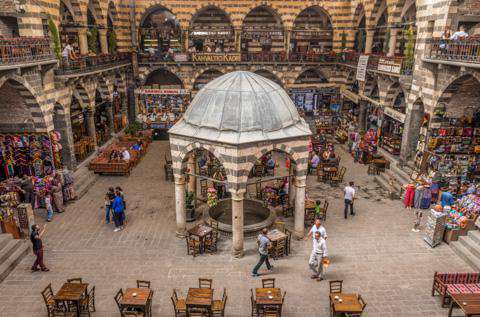How much does it cost to travel to Diyarbakir?
You should plan to spend around $117 (TRY3,778) per day on your vacation in Diyarbakir. This is the average daily price based on the expenses of other visitors.
Past travelers have spent, on average for one day:
- $20 (TRY646) on meals
- $30 (TRY986) on local transportation
- $153 (TRY4,942) on hotels
A one week trip to Diyarbakir for two people costs, on average, $1,634 (TRY52,887). This includes accommodation, food, local transportation, and sightseeing.
All of these average travel prices have been collected from other travelers to help you plan your own travel budget.
Independent Travel
Traveling Independently to Diyarbakir has many benefits including affordabilty, freedom, flexibility, and the opportunity to control your own experiences.
All of the travel costs below are based on the experiences of other independent travelers.
Is Diyarbakir expensive to visit?
Prices in Diyarbakir are reasonable and comparable to your average travel destination. Hotels, food, and sightseeing are generally within normal price ranges.
Within Europe, which is known to be an expensive region, Diyarbakir is a moderately priced destination compared to other places. The overall cost of travel here is fair for the region and comparable to Ankara or Rouen.
For more details, and to find out if it's within your travel budget, see Is Diyarbakir Expensive?
How much money do I need for a trip to Diyarbakir?
The average Diyarbakir trip cost is broken down by category here for independent travelers. All of these Diyarbakir travel prices are calculated from the budgets of real travelers.
|
Category
|
Cost
|
|
Accommodation 1
(Double Occupancy)
|
TRY4,942
($153)
|
|
Local Transportation 1
|
TRY986
($30)
|
|
Food 2
|
TRY646
($20)
|
|
Entertainment 1
|
TRY672
($21)
|
|
Alcohol 2
|
TRY285 -
855
($9 - 26)
|
Accommodation Budget in Diyarbakir
Calculated from travelers like you
The average price paid for one person for accommodation in Diyarbakir is $76 (TRY2,471). For two people sharing a typical double-occupancy hotel room, the average price paid for a hotel room in Diyarbakir is $153 (TRY4,942). This cost is from the reported spending of actual travelers.
Looking for a hotel in Diyarbakir? Prices vary by location, date, season, and the level of luxury. See below for options.
Transportation Budget in Diyarbakir
Calculated from travelers like you
-
The cost of a taxi ride in Diyarbakir is significantly more than public transportation. On average, past travelers have spent $30 (TRY986) per person, per day, on local transportation in Diyarbakir.
-
Transportation1
Taxis, local buses, subway, etc.
$30
TRY986
How much does it cost to go to Diyarbakir? Naturally, it depends on the dates. We recommend Kayak because they can find the best deals across all airlines.
The price of renting a car in Diyarbakir will depends on dates, the type of car, the location, and your age. We recommend Kayak because they can find the best deals across all car rental companies.
Food Budget in Diyarbakir
Calculated from travelers like you
-
While meal prices in Diyarbakir can vary, the average cost of food in Diyarbakir is $20 (TRY646) per day. Based on the spending habits of previous travelers, when dining out an average meal in Diyarbakir should cost around $7.98 (TRY258) per person. Breakfast prices are usually a little cheaper than lunch or dinner. The price of food in sit-down restaurants in Diyarbakir is often higher than fast food prices or street food prices.
-
Food2
Meals for one day
$20
TRY646
Typical prices for Food in Diyarbakir are listed below. These actual costs are from real travelers and can give you an idea of the prices in Diyarbakir, but your costs will vary based on your travel style and the place where the purchase was made.
-
Dessert
TRY6.00
-
Lunch for Two
TRY19
Entertainment Budget in Diyarbakir
Calculated from travelers like you
-
Entertainment and activities in Diyarbakir typically cost an average of $21 (TRY672) per person, per day based on the spending of previous travelers. This includes fees paid for admission tickets to museums and attractions, day tours, and other sightseeing expenses.
-
Entertainment1
Entrance tickets, shows, etc.
$21
TRY672
Alcohol Budget in Diyarbakir
Calculated from travelers like you
-
The average person spends about $18 (TRY570) on alcoholic beverages in Diyarbakir per day. The more you spend on alcohol, the more fun you might be having despite your higher budget.
-
Alcohol2
Drinks for one day
$18
TRY570
Diyarbakir On a Budget
 Diyarbakir, Turkey
Diyarbakir, Turkey
Diyarbakır is the largest city in Southeastern Turkey, located on the banks of Tigris River, which is one of two great rivers of the Middle East. The city is known especially for its old city, housed within ancient fortress walls that have been designated an UNESCO World Heritage Site. Within this fortress is a glimpse into the city's ancient history and traditional customs that remain alive today.
Sights
Most visitors to Diyarbakir come to see the historic sights and traditional life of the old city, which is situated within Diyarbakir Fortress, surrounded by ancient walls. The Fortress consists of an inner (the fort) and outer fortress (the walls) with four main gates: Da? Gate, Urfa Gate, Mardin Gate and Yeni Gate. As the widest and longest continuous defensive wall in the world (after the Great Wall of China), Diyarbakir Fortress was named an UNESCO World Heritage Site in 2015, along with Hevsel Gardens, which consist of the fertile lands stretching between the fortress and the Tigris River.
At the center of the old city, another must-see is the Great Mosque of Diyarbakir built by the Seljuk Turkish Sultan Malik Shah in the 11th century, and is one of the oldest mosques in Turkey. Other important mosques include those of the Ottoman era-the Behram Pasha Mosque (1572, known for its entrance arches) and Sheikh Matar Mosque (1520, known for its unique minaret based on four columns). These are just a few examples of the many historic mosques and churches within the city.
Neighborhoods
The city of Diyarbakir is made up of two main general areas-old city and new city. Old city is a compact area on the eastern side of the city, surrounded by ancient city walls that were built by Constantius II and extended by Valentinian I between 367 and 375 AD. There are four gates into the old city and 82 watch-towers on the walls. Within the old city visitors will find a more traditional side of Diyarbakir-many mosques and churches, bazaar markets, teahouses, and village-like communities where you'll likely see people, animals, and children (some of whom will beg or pickpocket) about in the streets. New city, on the other hand, is the next compact area to the west of the old city. Its central hub of activity is called Ofis, where there are many nice bars and cafes filled with students and young couples. New city is a hotspot for experiencing Diyarbakir's nightlife, and is generally safe due to an abundance of policemen.
Activities
Before delving into the sights of the old city, many visitors take a walk on the old city wall, starting at the northern gate and walking counterclockwise to Mardin Gate. It is free to access and offers some wonderful views of the surrounding area, sometimes even the Tigris River from one of the wall's watchtowers.
Travelers can also visit the Archaeological Museum for some deeper insight into Diyarbakir's past. The museum contains artifacts from the Neolithic period, through the Early Bronze Age, Assyrian, Urartu, Roman, Byzantine, Artuqids, Seljuk Turk, Aq Qoyunlu, and Ottoman Empire periods. The Cahit S?tk? Taranc? Museum is also unique, as it was the home of the late poet and serves as a classic example of a traditional Diyarbak?r home.
For experiencing the local culture, stop at one of the bazaars and delve into the world of bartering. The markets will have jewelry making and other craftwork like metal tools made from hand and local textiles. Shopping in the bazaars is a great way to get a sense of the local customs.
Food and Dining
A central ingredient to Diyarbakir dishes is lamb, often cooked with spices such as black pepper, sumac, and coriander, and served with rice, bulgur (a whole grain wheat dish), and butter. A few well-known dishes include meftune, which consists of lamb meat and vegetables cooked with garlic and sumac, and kaburga dolmas?, which is a baked lamb’s ribs stuffed with rice and spices. Other specialties include a sheep stew called seropeh, grilled lamb liver called ci?er kebab?, and a mixture of wheat grain, chickpeas, and yogurt called mehir. Desserts are very sweet, including items like kunefe, which is made with a thin dough, soaked in a sweet, sugar-based syrup, and layered with cheese-sometimes with other ingredients like clotted cream or nuts. What the city is truly famous for, however, is its watermelons, which are exported internationally. The city even holds an annual Watermelon Festival, and it is one of Diyarbakir's biggest events.
Transportation
The best way to reach Diyarbakir internationally is to first fly into Istanbul Ataturk Airport or Ankara Esenboga Airport. From either of these airports, Turkish Airlines offers daily domestic flights to Diyarbakir Airport, which is a military airbase and public airport. Travelers can also take a direct train, which runs five days a week. The journey by train takes about 21 hours. Transportation between cities is also available via bus.
We've been gathering travel costs from tens of thousands of actual travelers since 2010, and we use the data to calculate average daily travel costs for destinations around the world. We also systematically analyze the prices of hotels, hostels, and tours from travel providers such as Kayak, HostelWorld, TourRadar, Viator, and others. This combination of expenses from actual travelers, combined with pricing data from major travel companies, gives us a uniqe insight into the overall cost of travel for thousands of cities in countries around the world. You can see more here: How it Works.
 Diyarbakir, Turkey
Diyarbakir, Turkey

 Budget Your Trip is all about finding out how much everything costs so that you can travel cheaper and longer. Created by avid travelers Laurie and Bryan, our goal is to help you plan your next trip on the right budget. With average daily travel costs that are calculated from the budgets of real travelers, plus an analysis of hotel and tour prices, you can find out how much money you need to plan your next adventure. We also have plenty of travel advice, accommodation reviews, and activity suggestions.
Budget Your Trip is all about finding out how much everything costs so that you can travel cheaper and longer. Created by avid travelers Laurie and Bryan, our goal is to help you plan your next trip on the right budget. With average daily travel costs that are calculated from the budgets of real travelers, plus an analysis of hotel and tour prices, you can find out how much money you need to plan your next adventure. We also have plenty of travel advice, accommodation reviews, and activity suggestions.